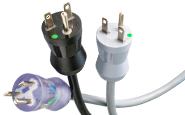Specifying International cords
Selection of the appropriate power cord (plug or connector on cable) or cord set (plug, connector on cable) for each export market is one of the easiest steps the equipment designer takes to assure the product can be easily plugged-in and used by their global customers.
Choosing a cord involves four steps:
1. Identify the correct plug for the country
2. Determine the desired rating of the power cord or cord set
3. Choose the correct cable
4. If a cord set, choose IEC 60320 power connector
World Plug and Socket Standards
There are 15 standard plug/socket patterns used throughout the world for Class I (grounded) and Class II (ungrounded) applications with current ratings from 2.5–16A depending on country and agency. These standards are Continental Europe, French Belgium, Europlug, Argentina, Australia / New Zealand, China, Denmark, India/South Africa, Israel, Italy, Japan, North America, Switzerland, Brazil and the United Kingdom/Ireland. See the Guide to Worldwide plugs and Socket Patterns.
100% of Interpower Manufactured cords are Tested
Power cords and cord sets are tested using the following procedures:
1. Ground continuity is determined at 25A.
2. Polarity and continuity are checked on each conductor to assure that line is connected to line, neutral to neutral, and ground to ground.
3. High voltage breakdown tests are performed at 2500VAC for one second between the primary conductors and ground conductor.
4. All plugs, connectors and cable are visually inspected for surface quality, molding flash, markings, etc.
5. Length of cords/cord sets is checked on a random sample basis.
Measuring Power Cords and Cord Sets
Interpower Corporation measures its power cords from the face of the connector or plug, not including pins, to the end of the cable, stripped or not. See illustration below.
Interpower cord sets are measured from the face of the connector to the face of the plug, not including pins. See illustration below.
Power Connections in Developing Countries
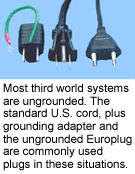 Information on electrical systems used in developing countries is imprecise. Formal electrical standards, where they exist, frequently do not cover plugs and sockets or are ignored in the marketplace. Furthermore, with regard to voltages and frequencies, power generating and distribution systems have been installed at various times by different contractors. These systems occasionally produce power at different frequencies and provide different voltages for final distribution. Therefore, some cities—even individual buildings in those cities—may be supplied by two or more generating plants and power distribution systems, each with a different single-phase voltage and frequency.
Information on electrical systems used in developing countries is imprecise. Formal electrical standards, where they exist, frequently do not cover plugs and sockets or are ignored in the marketplace. Furthermore, with regard to voltages and frequencies, power generating and distribution systems have been installed at various times by different contractors. These systems occasionally produce power at different frequencies and provide different voltages for final distribution. Therefore, some cities—even individual buildings in those cities—may be supplied by two or more generating plants and power distribution systems, each with a different single-phase voltage and frequency.
Most third world electrical distribution systems are ungrounded. Three-contact, grounded plugs, while mate-able with the 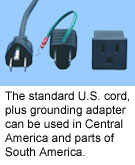 sockets, are not necessarily providing the expected equipment ground. An alternative method of equipment ground is advisable in these cases.
sockets, are not necessarily providing the expected equipment ground. An alternative method of equipment ground is advisable in these cases.
An ungrounded version of the North American NEMA 5-15 plug is commonly used in Central America and parts of South America. It is, therefore, common for equipment users to use a Class I to Class II adapter similar to Interpower part number 88100011. Interpower Corporation does not recommend cutting off the ground pin so that the plug can be mated with a two-pole, ungrounded socket. Another common international standard is the Europlug, an ungrounded version of the Continental European (German Schuko) standard.
IEC 60320 Power Connections
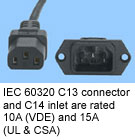 Whenever a detachable cord set is used, the mating connector must be included in the specification for the equipment. The connectors used throughout most of the world are defined in the IEC publication 60320. A common example is described as the standard sheets C13 (connector) and C14 (inlet). The C13 is rated by most agencies for service 10A at 70°C. UL and CSA allows its use up to 15A (220–240VAC). cord sets with molded-on cable connectors are available for most countries. These detachable cord sets make it easy for manufacturers to export products by using international plugs with the common IEC 60320 C13 connector.
Whenever a detachable cord set is used, the mating connector must be included in the specification for the equipment. The connectors used throughout most of the world are defined in the IEC publication 60320. A common example is described as the standard sheets C13 (connector) and C14 (inlet). The C13 is rated by most agencies for service 10A at 70°C. UL and CSA allows its use up to 15A (220–240VAC). cord sets with molded-on cable connectors are available for most countries. These detachable cord sets make it easy for manufacturers to export products by using international plugs with the common IEC 60320 C13 connector.
For lower amperages, IEC provides 2.5A connectors, either grounded or ungrounded. The grounded IEC 60320 C5 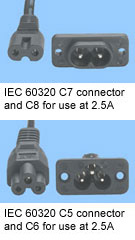 (connector) and C6 (inlet) are available with nine international plugs in this catalog. IEC 60320 C7 (connector) and C8 (inlet) are the ungrounded 2.5A connection. The C7 is commonly used with the Europlug and is available with five other international plugs. The C5, C6, C7, and C8 are rated at 70°C.
(connector) and C6 (inlet) are available with nine international plugs in this catalog. IEC 60320 C7 (connector) and C8 (inlet) are the ungrounded 2.5A connection. The C7 is commonly used with the Europlug and is available with five other international plugs. The C5, C6, C7, and C8 are rated at 70°C.
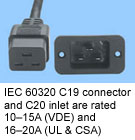 The IEC 60320 standard C19 (connector) and C20 (inlet), describes a connector rated at 16A/250VAC (20A in North America). It is rated at 70°C and permits detachable power connections for higher amperage requirements.
The IEC 60320 standard C19 (connector) and C20 (inlet), describes a connector rated at 16A/250VAC (20A in North America). It is rated at 70°C and permits detachable power connections for higher amperage requirements.
Accessory power connections, described in IEC 60320-2-2, can be powered almost anywhere in the world by using the accessory power system based on the international IEC 60320 connector pattern. Both 10–15A and 16–20A rated models are available.
The NEMA 5-15R socket used by North American manufacturers for accessory power applications is not recommended for use on exported products.
Cable Considerations
Determine jacket abrasion resistance needed for use on your product. Interpower power cords and cord sets are PVC jacketed and generally rated for use in off-the-floor office situations (Note: we can prepare made-to-order cable assemblies with rubber or TPE cable for harder service usage. Contact us for more information). See Cable Recommendations section for assistance in specifying cable.
Shielded cords
The use of shielded cords and cord sets on products that will be sold internationally presents special problems from an agency approval point of view. The reason is that shielded cords are not specifically covered by existing cable standards. The equipment manufacturer may be forced to incur the extra costs in getting an application approval to use the shielded cord set. VDE has tested and approved shielded cord sets in the past and therefore in Germany, at least, this may not be an overwhelming problem. Other countries, however, may not accept shielded cord sets. In general, shielded cords should be avoided whenever possible. Shielded cords are available only on a special order basis.
Power cords and cord Sets Approvals and Markings
Most international and North American agencies test and approve molded plugs separately from molded appliance connectors. The agencies normally specify on the approval documents a limited range of cable types, which are acceptable for use with molded plugs or IEC 60320 connectors. A typical cord set will have two or three separate approval documents. One will describe the molded plug and the type(s) of cable that is (are) acceptable. The second will reference the molded connector, again with reference to one or more specific cable types. The third will cover the cable itself.
• Europe—Most European agencies require that agency markings be molded directly into molded plugs and connectors. The cable itself will have the required marks either on the jacket or on the primary insulation. Alternatively it will incorporate a color-coded thread to identify the manufacturer.
• Australia—The Australian agencies require that an approval number be molded into the plug and appliance connector and that the cable be surface marked with information that also includes this approval number.
• United States—Effective February 2014, to differentiate UL certified power supply cords from other certifiers, UL requires that the ![]() be molded on the face of the attachment plug. This will help to identify that the complete power supply cord is UL certified. It will allow users of power supply cords to clearly identify what is UL certified, especially after the packaging, including the holographic label, has been removed. The use of the “UL” in a circle molded on the plug is in addition to, not in lieu of, the use of the holographic label, as both are needed as evidence of UL coverage.
be molded on the face of the attachment plug. This will help to identify that the complete power supply cord is UL certified. It will allow users of power supply cords to clearly identify what is UL certified, especially after the packaging, including the holographic label, has been removed. The use of the “UL” in a circle molded on the plug is in addition to, not in lieu of, the use of the holographic label, as both are needed as evidence of UL coverage.
• Canada—CSA’s requirements are similar to UL’s except that they require a CSA label on each cord that conforms to CSA requirements.
Why does the United Kingdom/Ireland plug have a fuse?
The United Kingdom is the only country that requires a fused power plug. The British use a ring wiring system in their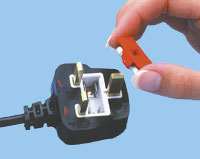 houses and buildings, which provides a secondary protection device at the plug, to minimize safety hazards. Circuits leave the local branch protection device, travel out to the loads (outlets or lamps, for example), and then return to the circuit protection device. In the Continental European and North American systems, all wiring is done on a linear basis—a circuit leaves the circuit protection device and goes straight to the outlets or lighting circuits, that represent the load, as illustrated below.
houses and buildings, which provides a secondary protection device at the plug, to minimize safety hazards. Circuits leave the local branch protection device, travel out to the loads (outlets or lamps, for example), and then return to the circuit protection device. In the Continental European and North American systems, all wiring is done on a linear basis—a circuit leaves the circuit protection device and goes straight to the outlets or lighting circuits, that represent the load, as illustrated below.
In the British ring wiring system, a fault condition at an outlet, for example, will be sourced with current from both directions. This minimizes the amount of heat generated in the conductor, as the fault condition occurs, but before the circuit protection device can clear the fault. By minimizing the heat generated, the degradation of insulation (which accompanies overheating due to repeated fault conditions) is also diminished, improving the long-term safety of the insulation system.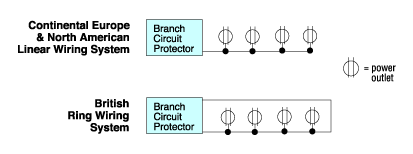
Until the circuit protection device clears the fault, however, the fault condition is sourced from two different directions in the supply system. There is therefore a much greater potential fault current condition. The British feel that a secondary protection device at the plug minimizes the safety hazard this condition creates; hence, the power plug fuse.
The fuse installed in all British plugs conforms to BS 1362 ("General purpose fuse links for domestic and similar purposes…"). The size of this fuse is 6.3 x 25.4mm. It has a breaking capacity rating of 6000A and is constructed with a sand-filled ceramic tube. The time-current characteristic on this family of fuses is not necessarily consistent with any other international standard, but it appears to have most of the characteristics of a fast acting fuse. The British Standards Institution standard for fuses in general is BS 4265.
More info on IEC 60320 Connector Power cords
International IEC 60320 C13 Connector Power cords
The power cords below have IEC 60320 C13 connectors molded onto harmonized cable which allows for detachable power connections at 10A internationally. They are stripped and ready for installation of the correct plug. See Rewireable plugs for international markets.These assemblies are for use with rewireable plugs when a complete molded cord set is not available or desired. Our manufacturing department can make assemblies for you. Call our Customer Service Department at (800) 662-2290 for more information.Important: Specify connector power cords with harmonized cable for international applications; AWG-type for North American.
North American IEC 60320 C13 Connector Power cords
The cords below have IEC 60320 C13 connectors molded onto North American AWG cable which allows for detachable power connections at 10A/250VAC. They are stripped and ready for installation of the correct plug.Suitable NEMA plugs for the 10A power cord are in the Rewireable plugs and sockets section. These assemblies are for use with rewireable plugs when a complete molded cord set is not available or desired. Our Manufacturing Department can make assemblies for you. Call our Customer Service Department at (800) 662-2290 for more information.Data Circuits - Danish and British
| Computers and other electrical devices that contain sensitive digital circuits usually need to be protected from spikes and surge currents conducted into the product via the line cord. In North America, this is normally accomplished with the use of plug-in surge protectors that are dedicated to one computer or work station. Although not yet as common in Europe as in the U.S., surge protection is frequently provided in Europe through the use of centrally protected circuits. In these installations, a power distribution system that can exclude non-protected appliances is desirable. The reason is that the presence of an inductive load, such as a vacuum cleaner for example, on a protected circuit would potentially reinsert brush noise and spikes as the vacuum was turned on and off. This could completely negate the central surge protection.The basis of the selective connection systems used in Denmark and the U.K., is the plug and socket. The Danish plug/socket is a Danish national standard. The British do not have an official standard on plugs and sockets for data circuits. But there is in fact, at least one unique data plug/socket system used by a large British computer manufacturer. | 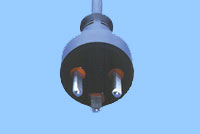 | ||
| Danish data plugThe Danish plug/socket pair is designed with specially shaped line and neutral contacts. The protected socket (not shown) will accept only the Danish data circuit plug; however, this data circuit plug may also be inserted into a standard outlet, if a protected outlet is not available. | |||
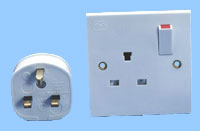 | |||
| United Kingdom data plug and socketThe British plug/socket pair, designed for use with protected data circuits, incorporates a special "T" shaped ground contact, which allows the data circuit plug to connect only to a protected outlet. The outlet, similarly, excludes all other standard plugs. | |||





